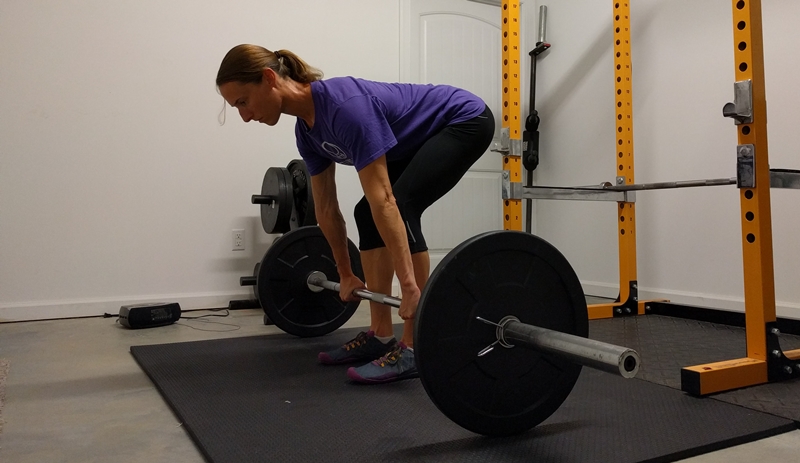Source https://www.niashanks.com/how-to-perform-barbell-rows-chin-ups/
 Two great exercises that will build a strong, resilient back (and posterior shoulders and biceps) are the barbell row and chin-up. The problem, however, is that these two exercises are frequently performed incorrectly, so trainees don’t reap the greatest benefits possible from the movements.
Two great exercises that will build a strong, resilient back (and posterior shoulders and biceps) are the barbell row and chin-up. The problem, however, is that these two exercises are frequently performed incorrectly, so trainees don’t reap the greatest benefits possible from the movements.
How to Perform Barbell Rows
Barbell rows are a dying exercise in most gyms. You rarely see anyone performing them anymore, and when you do, it’s often incorrectly. But if you train at home with just a barbell, or you prefer to train with large compound exercises that can be loaded progressively, the barbell row is an excellent addition to your exercise arsenal. (It’s also a good supplemental exercise to help build deadlift strength.)
The following video demonstrates how to perform this exercise correctly, plus a variation that gives your biceps a bit more work. Pay attention to the coaching cues.
As explained in the video, the most important thing when performing a barbell row is establishing, and maintaining, a rigid, neutral spine. This is why I recommend performing each rep from a dead stop, so you can make sure your back is set properly before each rep.
Barbell Row Alternatives
If you don’t have bumper plates or a way to safely elevate regular iron plates, as discussed in the video, use other exercises. Furthermore, if you want to give your low-back a break, there are other exercises that don’t put as much stress on that area.
One arm dumbbell row – this is one of my favorite row variations. Not only is it great for building strength in the back and biceps, but it’s also great for building grip strength. This is especially helpful for women because we have smaller hands than men, so that makes a standard barbell more challenging to hold on to. Building grip strength helps, and this exercise does that.
You can perform the one arm dumbbell row with a knee and same-side hand on a bench, with the other foot on the floor to reduce the demand on the low-back.
Inverted row – this is a great exercise, and it’s a good alternative to barbell rows. But instead of pulling a weighted barbell up to your body, you pull your body up to a bar. This exercise is included in the beginner strength training routine.
Chest supported row – these can be done with a machine (most gyms have one), or on a bench set at a low incline, with a dumbbell in each hand. Because of the “support” from the bench/machine, this movement limits the amount of weight that can be used, but it’s still a great pulling movement, especially if you want to give your low-back a break.
How to Perform Chin-ups
I refer to chin-ups as the upper body equivalent of the squat: it’s a big compound exercise that works a lot of muscle mass and requires you to move your body through space. Chin-ups work your back, biceps, posterior shoulders, and also your abs if you perform them with your legs straight and keep your pelvis in a neutral position.
The following video demonstrates a proper chin-up, and how to use leg drive for assistance.
How to Perform Assisted Chin-ups
For many women, achieving their first bodyweight chin-up seems like an elusive goal. Assisted chin-ups with a resistance band can help you get there, but make sure you do them correctly. Too commonly people butcher this exercise, allowing the band to do most of the work.
In this video I’m performing band assisted pull-ups (palms-down grip = pull-up; palms-up grip = chin-up). Notice how I lower slowly and pause briefly in the bottom position before pulling back up — do not use the band to “bounce” up.
Once you can use a small band and perform sets of five or more reps, use a more advanced variation to get even stronger.
By bending your knees before lowering down, you eliminate some of the assistance from the band, making your muscles do most of the work. If you can bust out a set of five reps taking 3-5 seconds to lower down with a very small band, you should be able to perform an unassisted chin-up.
What About Cable Pull-downs?
Cable pull-downs are a great option to train the vertical pulling movement. In particular, an overweight individual who finds it difficult to perform band assisted chin-ups should start with a pull-down. Likewise, someone who doesn’t have bands or wants to build their confidence with something a bit easier should start with pull-downs.
If you choose to start with pull-downs, get as strong as you can with that exercise in the 5-8 rep range, and then progress to band assisted chin-ups, demonstrated above.
Additional Barbell Exercise Demonstrations You’ll Love
Make sure you’re reaping the greatest benefits possible from your workouts by performing the best exercises correctly, and safely. Use the resources below to learn proper form, avoid the common mistakes (and find out how to correct them in case you’re making them now), and to organize them into a smart training program.
- How to Squat (Plus Common Mistakes and How to Correct Them)
- How to Deadlift, and Why Everyone Should
- How to Perform the Bench Press and Standing Press
- Ultimate Lift Like a Girl Workout Template
Want even more? Never miss a thing. Join the newsletter below and get the Beautiful Badass Mini Course as a gift.
The post How to Correctly Perform Barbell Rows and Chin-ups appeared first on Nia Shanks.